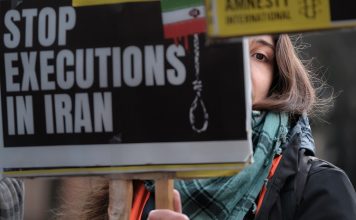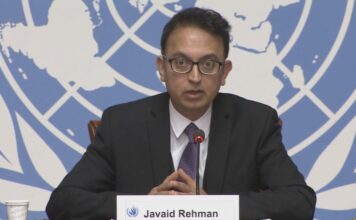By Kayhan Life Staff
Since the start of the Iranian year (March 21), 21 boys and nine girls younger than 18 years old have committed suicide in the western province of Kurdistan alone, showing a 100 percent increase since last year, a report by the Hengaw Human Rights Group said on July 26.
The latest child to commit suicide, Arya Jan Goli, was a 10-year-old boy who hanged himself on July 25, Hengaw said. Arya lived in the village of Singan in Oshnavieh county, in the northwestern province of West Azerbaijan. The report added that authorities had not released any more information about the teen.
According to Hengaw, three children committed suicide in the third week of July in the Kurdish region.
On July 23, another 10-year-old boy, Matin Mostafaei, who lived with his parents in the village of Chavrash near Urmia (Orumiyeh), in West Azerbaijan, committed suicide by hanging, the KURDPA Kurdish news agency reported.
“According to a source familiar with the situation, Matin worked in a shop,” KURDPA said. “He committed suicide when his father beat him after an argument. His body was taken to Urmia Hospital. The medical examiner’s office has not released Matin’s body to his parents, given that it showed signs of trauma and injuries.”
On July 21, Firefighters in Nishapur (Neyshabur), in the northeastern province of Khorasan Razavi, successfully prevented a 17-year girl from jumping off an underpass bridge, Human Rights Activists News Agency (HARANA) reported.
“On Thursday, July 21, members of the public alerted website 125 about a 17-year-old girl standing on top of an underpass bridge in Ferdowsi Square in Nishapur,” HARANA said, quoting the public relations office of Nishapur’s Fire and Public Safety Department. “Firefighters secured the area, grabbed the girl, and took her to safety.”
[aesop_image img=”https://kayhanlife.com/wp-content/uploads/2019/01/2017-05-16T120000Z_1163801819_RC1206397140_RTRMADP_3_IRAN-ELECTION-SOCIAL-MEDIA.jpg” panorama=”off” credit=”FILE PHOTO: Iranian youth use their mobile phones as they walk at a park in Tehran, Iran. REUTERS./FILE PHOTO” align=”center” lightbox=”on” captionsrc=”custom” captionposition=”left” revealfx=”off” overlay_revealfx=”off”]
According to human rights groups, there were at least eight recorded cases of child and adolescent suicides in June in Iran. Experts point to severe social and economic problems which have forced a large segment of the country’s population into poverty as the principal reason for the rising number of suicides among children.
A recent report by the Iranian Legal Medicine Organization (the national medical examiner’s office) said that the annual rate of suicide among children and adolescents had risen by 7 percent.
In comments reported by the Tehran-based Borna News on Sept. 6, 2019, Maryam Abbasinejad, the director of the Mental Health Office’s Suicide Prevention Program — a department with the Ministry of Health and Medical Education — warned: “The rate of suicide will increase by 5 percent every year. Western provinces have the highest rate of suicides.”
Recent research has shown that Iran’s suicide rate increased by 60 percent between 2015 and 2019.
In May, the Tehran-based Society for Protecting the Rights of Children (SPRC) published the result of recent research on the number of children and adolescent suicides between 2011 and 2020. The report said that 48 percent of recorded suicides involved boys, and 52 percent were girls.
The report noted that 45 percent of those who killed themselves were 9 and 14 years old, and the remaining 55 percent were between 15 and 18 years old.
The research found that poverty as a reason accounted for 7 percent of the suicides, educational issues for 26 percent, family disputes for 28 percent, emotional relationships for 5 percent, rape for 8 percent, forced marriages for 20 percent, and films and videos for 5 percent. The cities of Tehran, Isfahan (the capital of the central province of Isfahan), and Hamadan (the capital of the western province of Hamadan) had the highest rate of suicide.
According to some data, suicides among children and adolescents increased during the Coronavirus epidemic. Experts have attributed the increasing suicide rate among teens in the past three years to the economic crisis, which has forced an alarming number of households into poverty. Data has shown that children in rural and impoverished regions could not afford laptops, mobile phones, and tablets to allow online learning during the pandemic.
The Tehran-based Shargh newspaper published an article in its July 20 edition by Iranian psychologist Hossein Naseri, titled “Lower income, Poor Mental Health,” in which he said: “While social services and investing in our communities protect people’s mental health, poverty and other economic problems such as debts have the opposite effect. Economic and financial crises have a massive impact on people’s psychological health. Several studies have been done on the direct correlation between income and mental health.”
“In its June 1 edition, The Lancet [a British weekly peer-reviewed general medical journal] published the result of research on the correlation between socioeconomic status and mental health,” Mr. Naseri noted. “It is not surprising that many studies have shown people who are unemployed, live in poverty and have family problems caused by financial concerns, are more likely to develop mental health problems, have depression or commit suicide.”
“Negative effects of having a low income on a person’s mental health are much greater than the positive impacts of getting a raise. We see this more among the middle-class because a drop in income and inability to maintain a particular lifestyle threaten their socioeconomic status,” Naseri added.
“A change in income is followed by a subsequent change in wellbeing and mental health, suggesting a unidirectional causal effect of income on mental health and wellbeing,” an article titled “The Impact of Income on Mental Health” in The Lancet Public Health on June 1 said. “An improvement follows an increase in income in wellbeing.”
“The effect of income loss is more detrimental to mental health than an increase in income is for improving mental health, which has important implications for those living just above or below the poverty line for whom a drop in income can represent a substantial risk to income security and mental health,” The Lancet added.
“A growing body of evidence, mainly from high-income countries, has shown that there is a strong socioeconomic gradient in mental health, with people of lower socioeconomic status having a higher likelihood of developing and experiencing mental health problems,” a report by the UK-based Mental Health Foundation said. “Employment status is linked to mental health outcomes, with unemployed or economically inactive having higher rates of common mental health problems than employed.”











